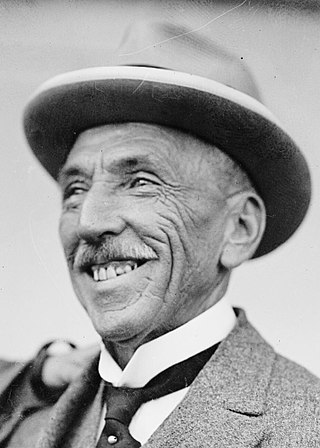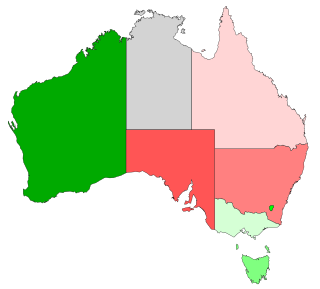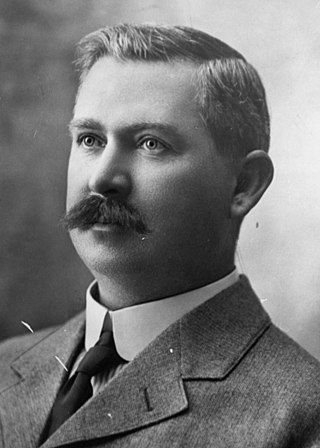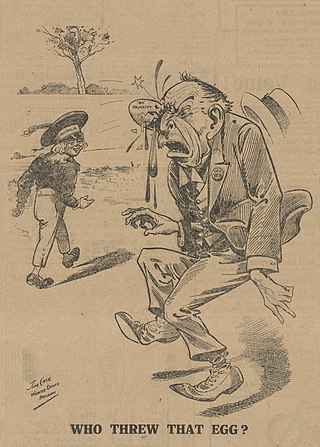
The Nationalist Party, also known as the National Party, was an Australian political party. It was formed in February 1917 from a merger between the Liberal Party and the National Labor Party, the latter formed by Prime Minister Billy Hughes and his supporters after the 1916 Labor Party split over World War I conscription. The Nationalist Party was established as a 'united' non-Labor opposition that had remained a political trend once the Labor party established itself in federal politics. The party was in government until electoral defeat in 1929. From that time it was the main opposition to the Labor Party until it merged with pro-Joseph Lyons Labor defectors to form the United Australia Party (UAP) in 1931. The party is a direct ancestor of the Liberal Party of Australia, the main centre-right party in Australia.

William Morris Hughes was an Australian politician who served as the seventh prime minister of Australia from 1915 to 1923. He is best known for leading the country during World War I, but his influence on national politics spanned several decades. Hughes was a member of federal parliament from Federation in 1901 until his death in 1952, the only person to have served for more than 50 years. He represented six political parties during his career, leading five, outlasting four, and being expelled from three.

Francis Gwynne Tudor was an Australian politician who served as the leader of the Australian Labor Party from 1916 until his death. He had previously been a government minister under Andrew Fisher and Billy Hughes.
The National Labor Party was formed by Australian Prime Minister Billy Hughes in 1916, following the 1916 Labor split on the issue of World War I conscription in Australia. Hughes had taken over as leader of the Australian Labor Party and Prime Minister of Australia when anti-conscriptionist Andrew Fisher resigned in 1915. He formed the new party for himself and his followers after he was expelled from the ALP a month after the 1916 plebiscite on conscription in Australia. Hughes held a pro-conscription stance in relation to World War I.

The 1916 Australian referendum, concerning how conscripted soldiers could be deployed, was held on 28 October 1916. It was the first non-binding Australian referendum, and contained one proposition, which was Prime Minister Billy Hughes' plan to allow conscripted troops to serve overseas during World War I.

The 1917 Australian referendum was held on 20 December 1917. It contained one question.

John Scaddan, CMG, popularly known as "Happy Jack", was Premier of Western Australia from 7 October 1911 until 27 July 1916.

William Arthur Holman was an Australian politician who served as Premier of New South Wales from 1913 to 1920. He came to office as the leader of the Labor Party, but was expelled from the party in the split of 1916. He subsequently became the inaugural leader of the NSW branch of the Nationalist Party.

The 1919 Australian federal election was held on 13 December 1919 to elect members to the Parliament of Australia. All 75 seats in the House of Representatives and 19 of the 36 seats in the Senate were up for election. The incumbent Nationalist Party government won re-election, with Prime Minister Billy Hughes continuing in office.

The 1917 Australian federal election was held in Australia on 5 May 1917. All 75 seats in the House of Representatives and 18 of the 36 seats in the Senate were up for election. The incumbent Nationalist Party, led by Prime Minister Billy Hughes, defeated the opposition Labor Party led by Frank Tudor in a landslide.
This is a list of the members of the Australian House of Representatives in the Sixth Australian Parliament, which was elected at the 1914 election on 5 September 1914.
This is a list of members of the Australian Senate from 1914 to 1917. The 5 September 1914 election was a double dissolution called by Prime Minister of Australia Joseph Cook in an attempt to gain control of the Senate. All 75 seats in the House of Representatives, and all 36 seats in the Senate were up for election. The incumbent Commonwealth Liberal Party was defeated by the opposition Australian Labor Party led by Andrew Fisher, who announced with the outbreak of World War I during the campaign that under a Labor government, Australia would "stand beside the mother country to help and defend her to the last man and the last shilling."
This is a list of members of the 20th Legislative Assembly of Queensland from 1915 to 1918, as elected at the 1915 state election held on 22 May 1915.
During the second half of World War I, the First Australian Imperial Force experienced a shortage of men as the number of men volunteering to fight overseas declined and the casualty rate increased. At the time, military service within the Commonwealth of Australia and its territories was compulsory for Australian men, but that requirement did not extend to conflict outside of Australia. In 1916, Prime Minister Billy Hughes called a plebiscite to determine public support for extending conscription to include military service outside the Commonwealth for the duration of the war. The referendum, held on 28 October 1916, narrowly rejected the proposal. A second plebiscite, held a year later on 20 December 1917, also failed to gain a majority.

Thomas Joseph Ryan was an Australian politician who served as Premier of Queensland from 1915 to 1919, as leader of the state Labor Party. He resigned to enter federal politics, sitting in the House of Representatives for the federal Labor Party from 1919 until his premature death less than two years later.
The history of the Australian Labor Party has its origins in the Labour parties founded in the 1890s in the Australian colonies prior to federation. Labor tradition ascribes the founding of Queensland Labour to a meeting of striking pastoral workers under a ghost gum tree in Barcaldine, Queensland in 1891. The Balmain, New South Wales branch of the party claims to be the oldest in Australia. Labour as a parliamentary party dates from 1891 in New South Wales and South Australia, 1893 in Queensland, and later in the other colonies.

The 1917 Victorian state election was held in the Australian state of Victoria on Thursday 15 November 1917 for the state's Legislative Assembly. 51 of the 65 Legislative Assembly seats were contested.

On 29 November 1917, an egg was thrown at the Australian Prime Minister Billy Hughes at the Warwick railway station, Queensland, during his campaign for the 1917 plebiscite on conscription. The egg was thrown by Patrick Michael Brosnan, possibly assisted by his brother Bartie Brosnan.
The Kidstonites or Kidston party were a political party in the Australian state of Queensland in 1907 to 1908, formed by William Kidston. The party resulted from a split in the Queensland Labor Party and spent most of its existence in government, before merging with the conservative faction of Robert Philp in October 1908, to form the Liberal Party.
The Liberal Party was a political party in the Australian state of Queensland in the early 20th century. It combined the main non-Labor forces, the Kidstonites of William Kidston and the Conservative Party led by Robert Philp, similar to the federal Commonwealth Liberal Party whose fusion it preceded. The Liberals held government from their formation in 1908 until defeat in 1915 after which they combined with other elements in the state to form the National Party.











